【实例简介】Understanding LTE with MATLAB(使用 MATLAB 了解 LTE)
本书通过关键核心技术的理论概览、简明扼要地讨论LTE标准规范和用于仿真LTE标准所需的MATLAB算法这三个部分审视了LTE标准的物理层,并通过一系列的程序,展现了每一种LTE的核心技术,通过一步步综合这些核心技术,最终建立LTE物理层的系统模型并评价系统性能。通过这一循序渐进的过程,读者将会在仿真中深入理解LTE的技术构思和标准规范。本书适合通信、电子工程和计算机专业的学生、研究者和教授阅读、也可供通信系统的工程师、设计师和配置人员参考。
【实例截图】

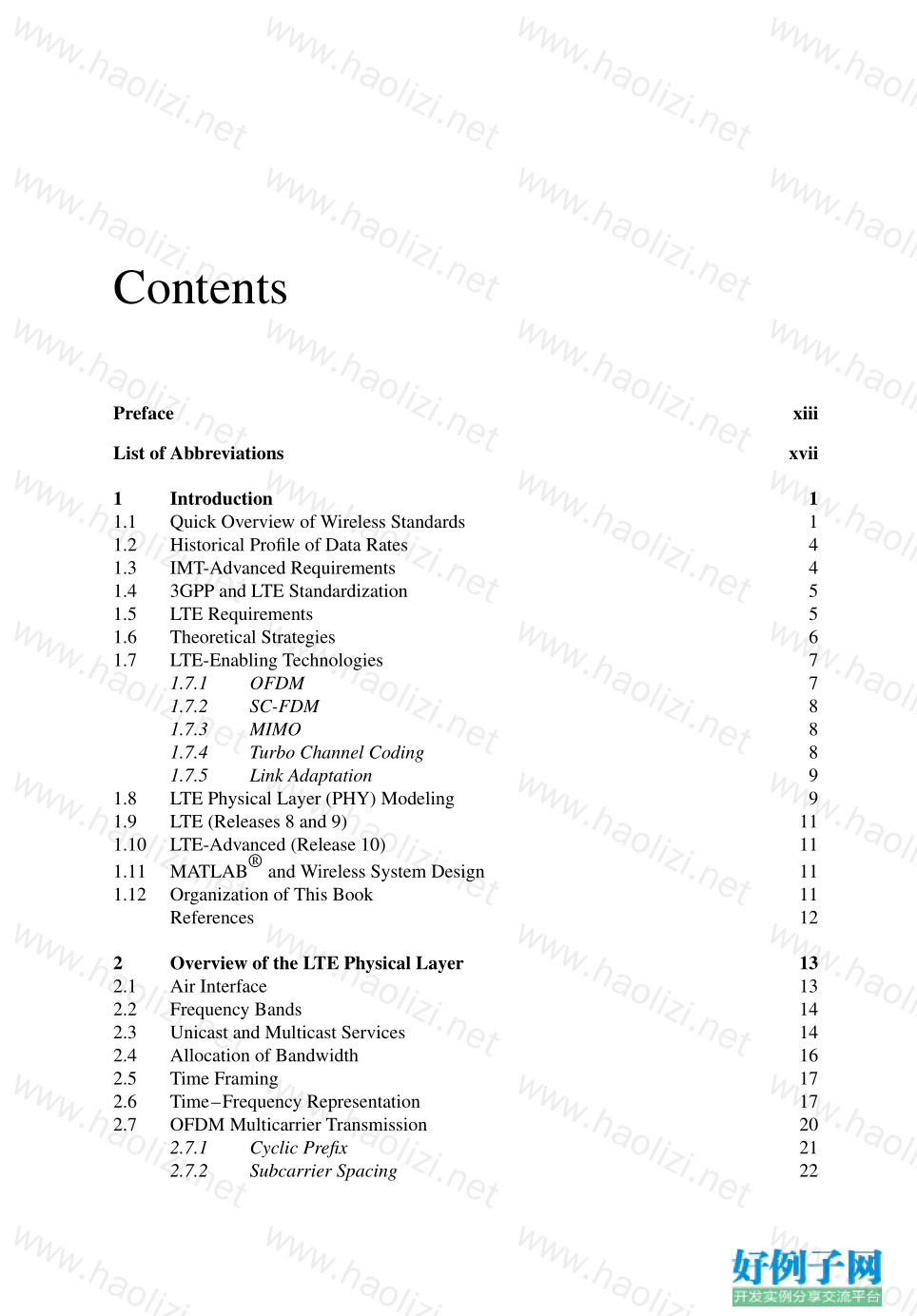
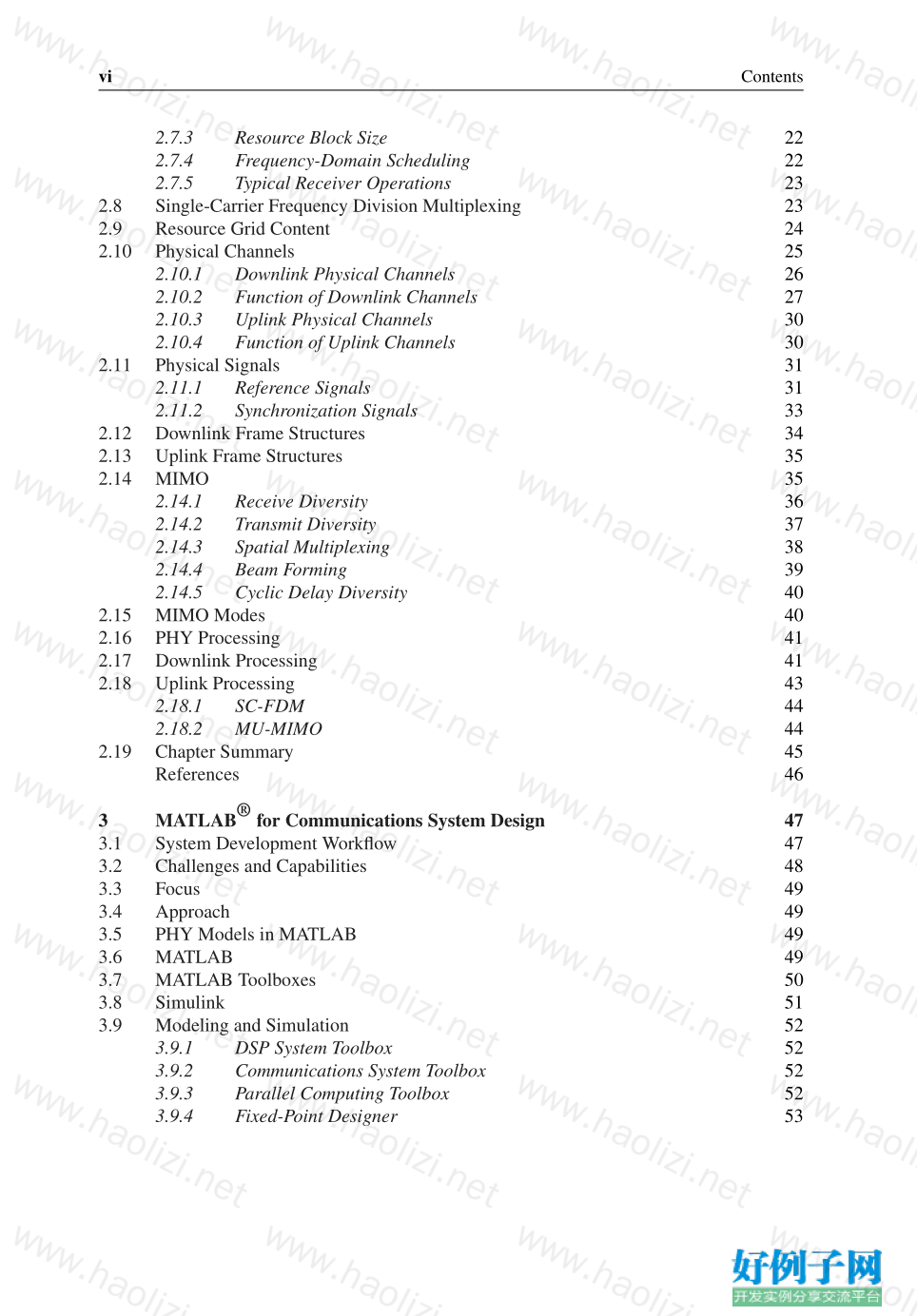
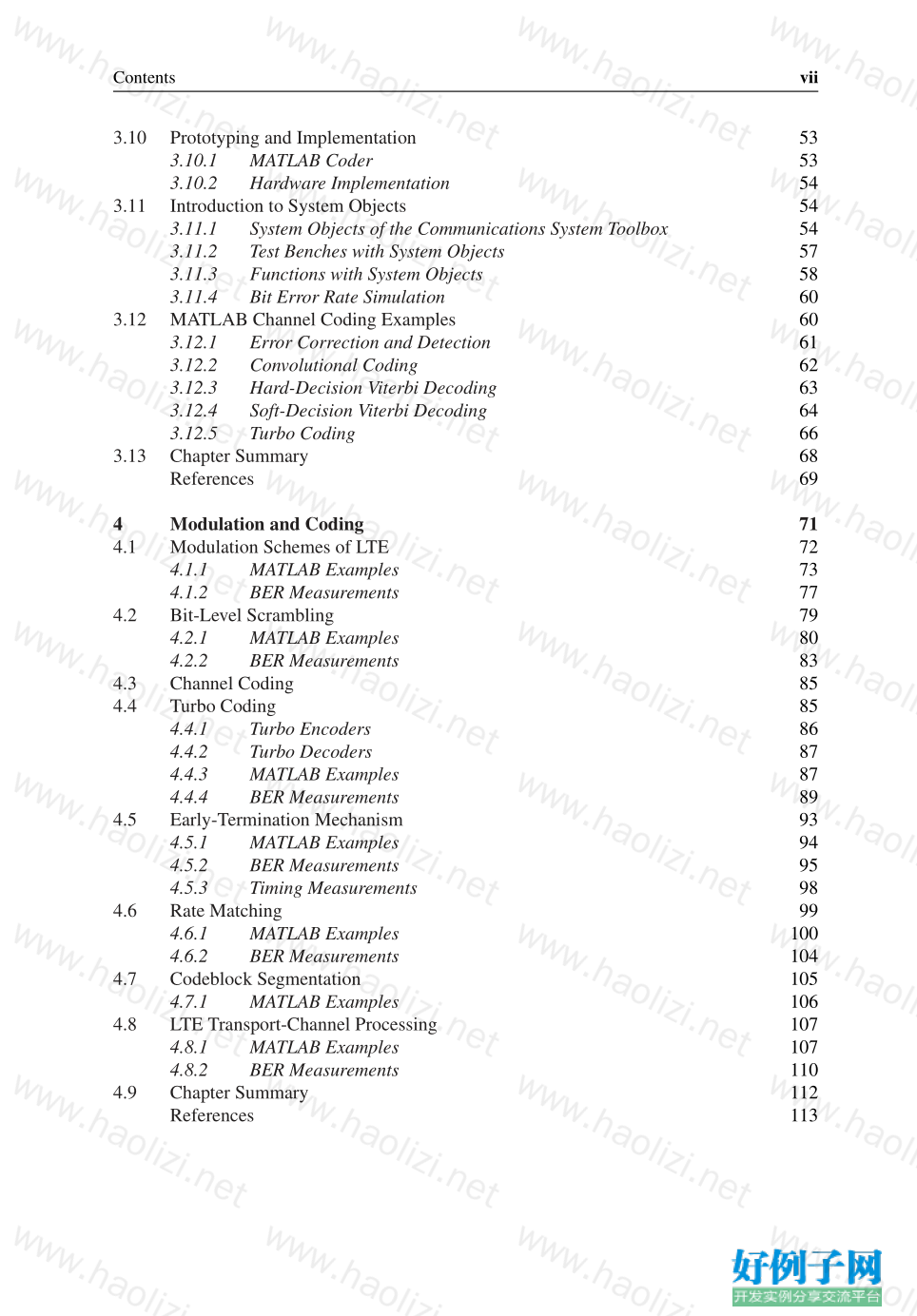
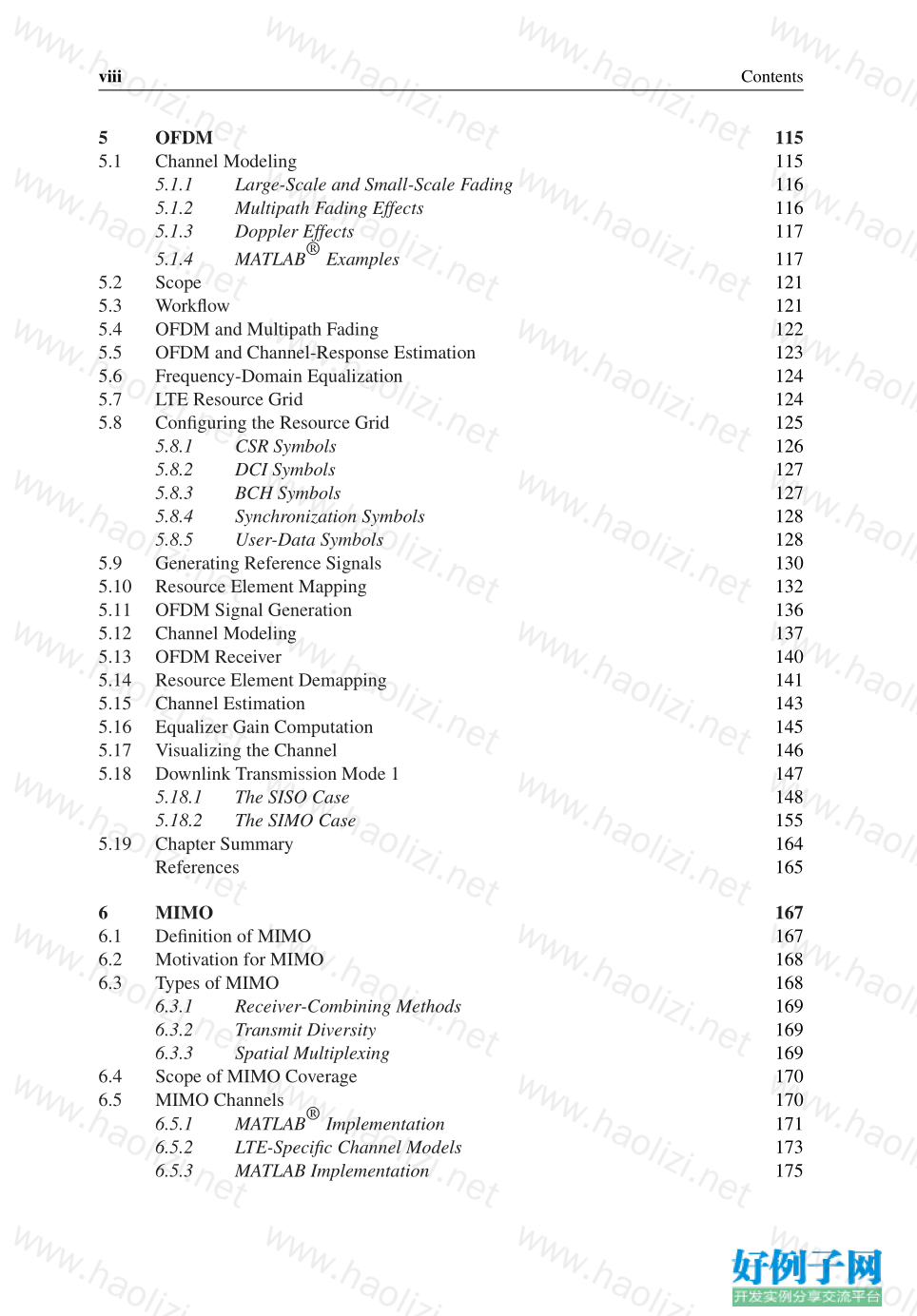

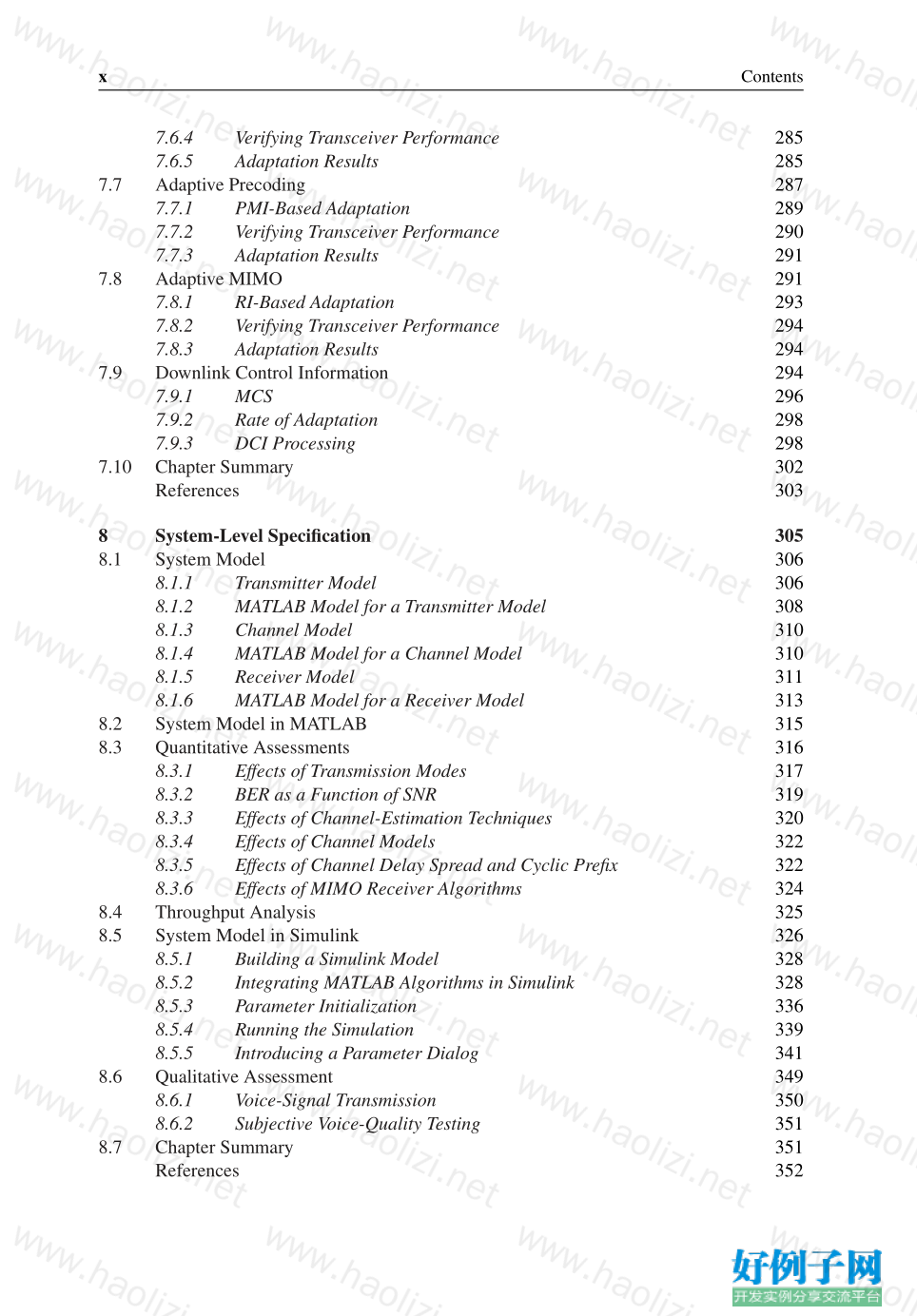
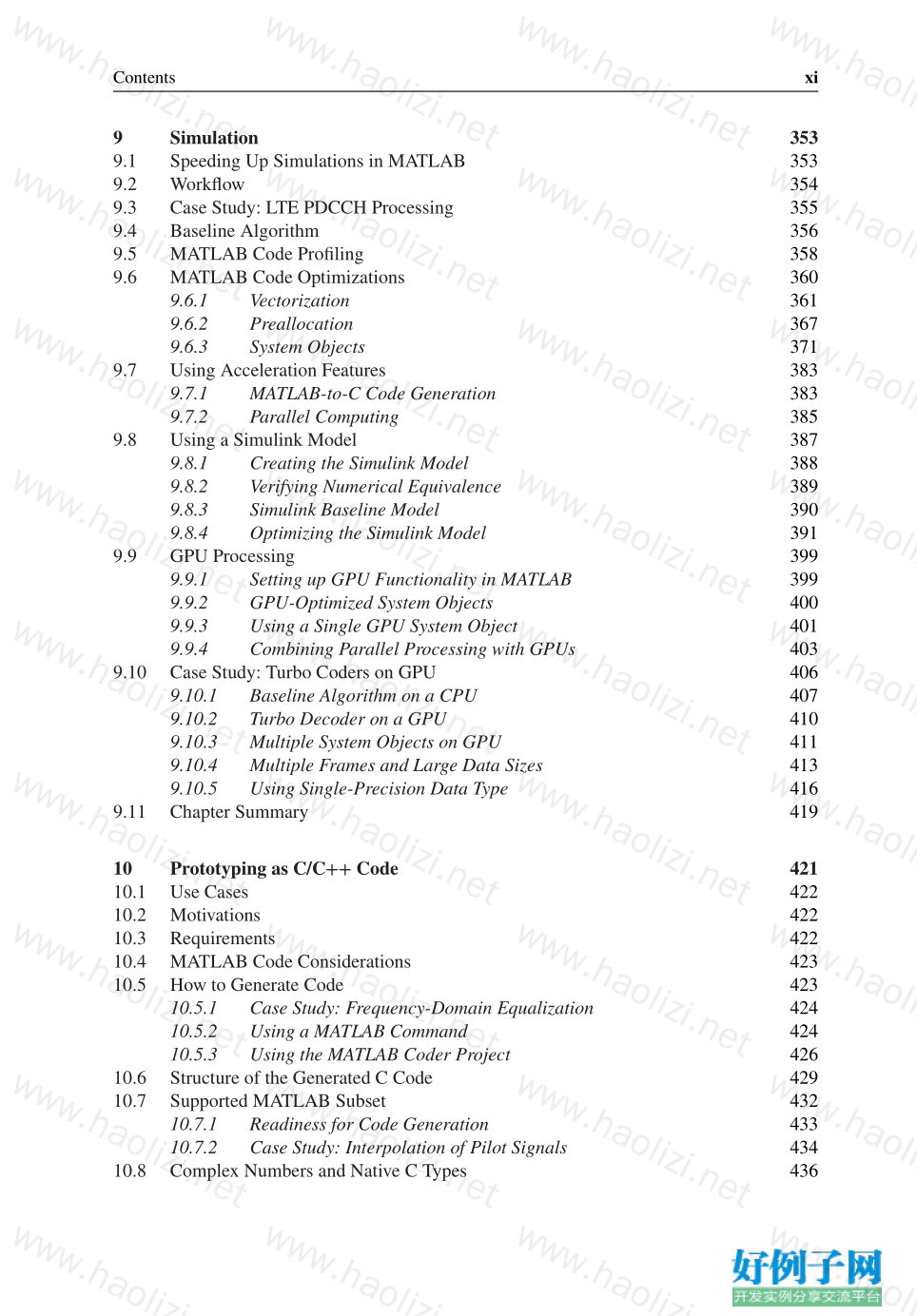
【核心代码】
Contents
Preface
xiii
List of Abbreviations xvii
1 Introduction 1
1.1 Quick Overview of Wireless Standards 1
1.2 Historical Profile of Data Rates 4
1.3 IMT-Advanced Requirements 4
1.4 3GPP and LTE Standardization 5
1.5 LTE Requirements 5
1.6 Theoretical Strategies 6
1.7 LTE-Enabling Technologies 7
1.7.1 OFDM
7
1.7.2 SC-FDM
8
1.7.3 MIMO
8
1.7.4 Turbo Channel Coding
8
1.7.5 Link Adaptation
9
1.8 LTE Physical Layer (PHY) Modeling 9
1.9 LTE (Releases 8 and 9) 11
1.10 LTE-Advanced (Release 10) 11
1.11 MATLAB
®
and Wireless System Design 11
1.12 Organization of This Book 11
References 12
2 Overview of the LTE Physical Layer 13
2.1 Air Interface 13
2.2 Frequency Bands 14
2.3 Unicast and Multicast Services 14
2.4 Allocation of Bandwidth 16
2.5 Time Framing 17
2.6 Time–Frequency Representation 17
2.7 OFDM Multicarrier Transmission 20
2.7.1 Cyclic Prefix
21
2.7.2 Subcarrier Spacing
22vi
Contents
2.7.3 Resource Block Size
22
2.7.4 Frequency-Domain Scheduling
22
2.7.5 Typical Receiver Operations
23
2.8 Single-Carrier Frequency Division Multiplexing
23
2.9 Resource Grid Content
24
2.10 Physical Channels
25
2.10.1 Downlink Physical Channels
26
2.10.2 Function of Downlink Channels
27
2.10.3 Uplink Physical Channels
30
2.10.4 Function of Uplink Channels
30
2.11 Physical Signals
31
2.11.1 Reference Signals
31
2.11.2 Synchronization Signals
33
2.12 Downlink Frame Structures
34
2.13 Uplink Frame Structures
35
2.14 MIMO
35
2.14.1 Receive Diversity
36
2.14.2 Transmit Diversity
37
2.14.3 Spatial Multiplexing
38
2.14.4 Beam Forming
39
2.14.5 Cyclic Delay Diversity
40
2.15 MIMO Modes
40
2.16 PHY Processing
41
2.17 Downlink Processing
41
2.18 Uplink Processing
43
2.18.1 SC-FDM
44
2.18.2 MU-MIMO
44
2.19 Chapter Summary
45
References
46
3 MATLAB
®
for Communications System Design 47
3.1 System Development Workflow
47
3.2 Challenges and Capabilities
48
3.3 Focus
49
3.4 Approach
49
3.5 PHY Models in MATLAB
49
3.6 MATLAB
49
3.7 MATLAB Toolboxes
50
3.8 Simulink
51
3.9 Modeling and Simulation
52
3.9.1 DSP System Toolbox
52
3.9.2 Communications System Toolbox
52
3.9.3 Parallel Computing Toolbox
52
3.9.4 Fixed-Point Designer
53Contents
vii
3.10 Prototyping and Implementation
53
3.10.1 MATLAB Coder
53
3.10.2 Hardware Implementation
54
3.11 Introduction to System Objects
54
3.11.1 System Objects of the Communications System Toolbox
54
3.11.2 Test Benches with System Objects
57
3.11.3 Functions with System Objects
58
3.11.4 Bit Error Rate Simulation
60
3.12 MATLAB Channel Coding Examples
60
3.12.1 Error Correction and Detection
61
3.12.2 Convolutional Coding
62
3.12.3 Hard-Decision Viterbi Decoding
63
3.12.4 Soft-Decision Viterbi Decoding
64
3.12.5 Turbo Coding
66
3.13 Chapter Summary
68
References
69
4 Modulation and Coding 71
4.1 Modulation Schemes of LTE
72
4.1.1 MATLAB Examples
73
4.1.2 BER Measurements
77
4.2 Bit-Level Scrambling
79
4.2.1 MATLAB Examples
80
4.2.2 BER Measurements
83
4.3 Channel Coding
85
4.4 Turbo Coding
85
4.4.1 Turbo Encoders
86
4.4.2 Turbo Decoders
87
4.4.3 MATLAB Examples
87
4.4.4 BER Measurements
89
4.5 Early-Termination Mechanism
93
4.5.1 MATLAB Examples
94
4.5.2 BER Measurements
95
4.5.3 Timing Measurements
98
4.6 Rate Matching
99
4.6.1 MATLAB Examples
100
4.6.2 BER Measurements
104
4.7 Codeblock Segmentation
105
4.7.1 MATLAB Examples
106
4.8 LTE Transport-Channel Processing
107
4.8.1 MATLAB Examples
107
4.8.2 BER Measurements
110
4.9 Chapter Summary
112
References
113viii
Contents
5 OFDM 115
5.1 Channel Modeling
115
5.1.1 Large-Scale and Small-Scale Fading
116
5.1.2 Multipath Fading Effects
116
5.1.3 Doppler Effects
117
5.1.4 MATLAB
®
Examples
117
5.2 Scope
121
5.3 Workflow
121
5.4 OFDM and Multipath Fading
122
5.5 OFDM and Channel-Response Estimation
123
5.6 Frequency-Domain Equalization
124
5.7 LTE Resource Grid
124
5.8 Configuring the Resource Grid
125
5.8.1 CSR Symbols
126
5.8.2 DCI Symbols
127
5.8.3 BCH Symbols
127
5.8.4 Synchronization Symbols
128
5.8.5 User-Data Symbols
128
5.9 Generating Reference Signals
130
5.10 Resource Element Mapping
132
5.11 OFDM Signal Generation
136
5.12 Channel Modeling
137
5.13 OFDM Receiver
140
5.14 Resource Element Demapping
141
5.15 Channel Estimation
143
5.16 Equalizer Gain Computation
145
5.17 Visualizing the Channel
146
5.18 Downlink Transmission Mode 1
147
5.18.1 The SISO Case
148
5.18.2 The SIMO Case
155
5.19 Chapter Summary
164
References
165
6 MIMO 167
6.1 Definition of MIMO
167
6.2 Motivation for MIMO
168
6.3 Types of MIMO
168
6.3.1 Receiver-Combining Methods
169
6.3.2 Transmit Diversity
169
6.3.3 Spatial Multiplexing
169
6.4 Scope of MIMO Coverage
170
6.5 MIMO Channels
170
6.5.1 MATLAB
®
Implementation
171
6.5.2 LTE-Specific Channel Models
173
6.5.3 MATLAB Implementation
175Contents
ix
6.5.4 Initializing MIMO Channels
176
6.5.5 Adding AWGN
177
6.6 Common MIMO Features
178
6.6.1 MIMO Resource Grid Structure
178
6.6.2 Resource-Element Mapping
179
6.6.3 Resource-Element Demapping
183
6.6.4 CSR-Based Channel Estimation
186
6.6.5 Channel-Estimation Function
188
6.6.6 Channel-Estimate Expansion
190
6.6.7 Ideal Channel Estimation
194
6.6.8 Channel-Response Extraction
196
6.7 Specific MIMO Features
197
6.7.1 Transmit Diversity
197
6.7.2 Transceiver Setup Functions
205
6.7.3 Downlink Transmission Mode 2
215
6.7.4 Spatial Multiplexing
221
6.7.5 MIMO Operations in Spatial Multiplexing
225
6.7.6 Downlink Transmission Mode 4
234
6.7.7 Open-Loop Spatial Multiplexing
248
6.7.8 Downlink Transmission Mode 3
253
6.8 Chapter Summary
260
References
262
7 Link Adaptation 263
7.1 System Model
264
7.2 Link Adaptation in LTE
265
7.2.1 Channel Quality Estimation
266
7.2.2 Precoder Matrix Estimation
266
7.2.3 Rank Estimation
266
7.3 MATLAB
®
Examples
266
7.3.1 CQI Estimation
267
7.3.2 PMI Estimation
270
7.3.3 RI Estimation
271
7.4 Link Adaptations between Subframes
275
7.4.1 Structure of the Transceiver Model
275
7.4.2 Updating Transceiver Parameter Structures
276
7.5 Adaptive Modulation
277
7.5.1 No Adaptation
277
7.5.2 Changing the Modulation Scheme at Random
278
7.5.3 CQI-Based Adaptation
279
7.5.4 Verifying Transceiver Performance
280
7.5.5 Adaptation Results
281
7.6 Adaptive Modulation and Coding Rate
283
7.6.1 No Adaptation
283
7.6.2 Changing Modulation Scheme at Random
283
7.6.3 CQI-Based Adaptation
284x
Contents
7.6.4 Verifying Transceiver Performance
285
7.6.5 Adaptation Results
285
7.7 Adaptive Precoding
287
7.7.1 PMI-Based Adaptation
289
7.7.2 Verifying Transceiver Performance
290
7.7.3 Adaptation Results
291
7.8 Adaptive MIMO
291
7.8.1 RI-Based Adaptation
293
7.8.2 Verifying Transceiver Performance
294
7.8.3 Adaptation Results
294
7.9 Downlink Control Information
294
7.9.1 MCS
296
7.9.2 Rate of Adaptation
298
7.9.3 DCI Processing
298
7.10 Chapter Summary
302
References
303
8 System-Level Specification 305
8.1 System Model
306
8.1.1 Transmitter Model
306
8.1.2 MATLAB Model for a Transmitter Model
308
8.1.3 Channel Model
310
8.1.4 MATLAB Model for a Channel Model
310
8.1.5 Receiver Model
311
8.1.6 MATLAB Model for a Receiver Model
313
8.2 System Model in MATLAB
315
8.3 Quantitative Assessments
316
8.3.1 Effects of Transmission Modes
317
8.3.2 BER as a Function of SNR
319
8.3.3 Effects of Channel-Estimation Techniques
320
8.3.4 Effects of Channel Models
322
8.3.5 Effects of Channel Delay Spread and Cyclic Prefix
322
8.3.6 Effects of MIMO Receiver Algorithms
324
8.4 Throughput Analysis
325
8.5 System Model in Simulink
326
8.5.1 Building a Simulink Model
328
8.5.2 Integrating MATLAB Algorithms in Simulink
328
8.5.3 Parameter Initialization
336
8.5.4 Running the Simulation
339
8.5.5 Introducing a Parameter Dialog
341
8.6 Qualitative Assessment
349
8.6.1 Voice-Signal Transmission
350
8.6.2 Subjective Voice-Quality Testing
351
8.7 Chapter Summary
351
References
352Contents
xi
9 Simulation 353
9.1 Speeding Up Simulations in MATLAB
353
9.2 Workflow
354
9.3 Case Study: LTE PDCCH Processing
355
9.4 Baseline Algorithm
356
9.5 MATLAB Code Profiling
358
9.6 MATLAB Code Optimizations
360
9.6.1 Vectorization
361
9.6.2 Preallocation
367
9.6.3 System Objects
371
9.7 Using Acceleration Features
383
9.7.1 MATLAB-to-C Code Generation
383
9.7.2 Parallel Computing
385
9.8 Using a Simulink Model
387
9.8.1 Creating the Simulink Model
388
9.8.2 Verifying Numerical Equivalence
389
9.8.3 Simulink Baseline Model
390
9.8.4 Optimizing the Simulink Model
391
9.9 GPU Processing
399
9.9.1 Setting up GPU Functionality in MATLAB
399
9.9.2 GPU-Optimized System Objects
400
9.9.3 Using a Single GPU System Object
401
9.9.4 Combining Parallel Processing with GPUs
403
9.10 Case Study: Turbo Coders on GPU
406
9.10.1 Baseline Algorithm on a CPU
407
9.10.2 Turbo Decoder on a GPU
410
9.10.3 Multiple System Objects on GPU
411
9.10.4 Multiple Frames and Large Data Sizes
413
9.10.5 Using Single-Precision Data Type
416
9.11 Chapter Summary
419
10 Prototyping as C/C Code 421
10.1 Use Cases
422
10.2 Motivations
422
10.3 Requirements
422
10.4 MATLAB Code Considerations
423
10.5 How to Generate Code
423
10.5.1 Case Study: Frequency-Domain Equalization
424
10.5.2 Using a MATLAB Command
424
10.5.3 Using the MATLAB Coder Project
426
10.6 Structure of the Generated C Code
429
10.7 Supported MATLAB Subset
432
10.7.1 Readiness for Code Generation
433
10.7.2 Case Study: Interpolation of Pilot Signals
434
10.8 Complex Numbers and Native C Types
436xii
Contents
10.9 Support for System Toolboxes
438
10.9.1 Case Study: FFT and Inverse FFT
439
10.10 Support for Fixed-Point Data
444
10.10.1 Case Study: FFT Function
445
10.11 Support for Variable-Sized Data
447
10.11.1 Case Study: Adaptive Modulation
448
10.11.2 Fixed-sized Code Generation
449
10.11.3 Bounded Variable-Sized Data
454
10.11.4 Unbounded Variable-Sized Data
456
10.12 Integration with Existing C/C Code
458
10.12.1 Algorithm
458
10.12.2 Executing MATLAB Testbench
460
10.12.3 Generating C Code
463
10.12.4 Entry-Point Functions in C
463
10.12.5 C Main Function
467
10.12.6 Compiling and Linking
468
10.12.7 Executing C Testbench
469
10.13 Chapter Summary
471
References
471
11 Summary 473
11.1 Modeling
473
11.1.1 Theoretical Considerations
474
11.1.2 Standard Specifications
474
11.1.3 Algorithms in MATLAB
®
474
11.2 Simulation
476
11.2.1 Simulation Acceleration
476
11.2.2 Acceleration Methods
477
11.2.3 Implementation
477
11.3 Directions for Future Work
477
11.3.1 User-Plane Details
478
11.3.2 Control-Plane Processing
479
11.3.3 Hybrid Automatic Repeat Request
479
11.3.4 System-Access Modules
479
11.4 Concluding Remarks
480
Index
483











网友评论
我要评论